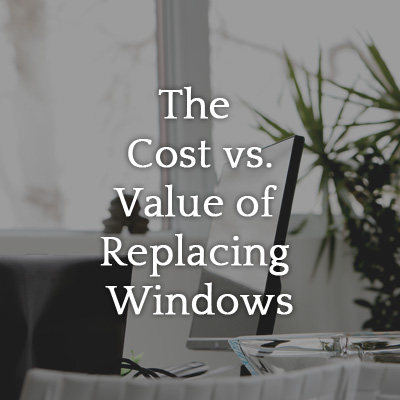 Are you thinking about upgrading your old, drafty windows, but bristle at the thought of writing the check? You aren’t alone. Homeowners often struggle with the expense that comes with replacing windows. However, upgrading old windows should be viewed not as a cost, but as an investment. The value of replacing windows can be realized in both annual energy savings and the improved resale value that new windows add to the home.
Are you thinking about upgrading your old, drafty windows, but bristle at the thought of writing the check? You aren’t alone. Homeowners often struggle with the expense that comes with replacing windows. However, upgrading old windows should be viewed not as a cost, but as an investment. The value of replacing windows can be realized in both annual energy savings and the improved resale value that new windows add to the home. How Energy Is Lost Through Windows
Heat always flows from warm areas into cooler areas. In winter, heat will flow out of the house; in summer, heat will attempt to flow in. In cold months, inefficient and poorly insulated windows cause drafts in the home. Those drafts are often due to gaps in the window frame, but they are also caused by the air flow and clash of temperatures around the windows. Warm air near a cold window pane will cool quickly, creating a cycle of moving air that results in a drafty feeling. Replacement windows will not only close gaps in the window frame, but can lessen the effect of air temperature drops near the window glass.In the summer, the opposite happens. The sun has a significant impact on the temperature of a room. While closing blinds and curtains may help, windows with a low solar heat gain coefficient will lessen the effect by decreasing temperature fluxions, allowing homeowners to let sunlight in, without “baking” the room.
The Impact of Replacing Windows
Modern, high-efficiency windows are typically double paned, argon-gas filled, and coated with a low-emissive film that offers more than twice the insulation value of single-pane windows typically found in older and historic homes. These windows can cut energy loss by 50 percent. Considering that 30 percent of a home’s heating and air conditioning flies out the window, replacing older single-pane models can significantly decrease energy loss.The Environmental Protection Agency estimates that the average household spends anywhere from $1500 to $2500 per year on energy bills, with 45 percent of that cost going towards heating and cooling. According to Efficient Windows Collaborative, a coalition of researchers, window manufacturers, and government-associated agencies, homeowners in a 2,000 square foot home can save $126 to $464 a year when they replace single pane windows with energy-efficient windows.
Always Consider the Resale Impact of Replacing Windows
Replacing windows doesn’t just improve energy efficiency, it can also significantly impact the resale value of a home, especially in historic homes. Buyers are likely to shy away from or offer less money on older homes with older windows, as they know their energy bills will be high and the will eventually have to spend the money to replace the windows themselves.When replacing windows, especially in older homes, it is extremely important to choose windows that match the building structure.
Often times, choosing economy-grade windows will actually detract from the resale value, rather than enhancing it. So, for example, if a home is over 100 years old and maintains much of its original woodwork, homeowners will want to choose wood windows that will maintain the historic feel of the home. According to Remodeling Magazine, homeowners get back, on average, 80 percent of their window replacement costs by the time they sell their homes when they take the time to select windows that match the architectural style and structure of the building.
When Is It Time To Replace Windows?
There is not a singular formula for homeowners to follow in order to know when to buy replacement windows. As a general rule, windows that are more than 15 years old should be considered. Other strong red flags include single-pane windows, moisture on the interior of the window, the ability to hear outside noise clearly when the windows are closed, windows that, difficulty opening or closing the windows, and windows that still require storm panes. Replacing windows doesn’t come cheap, but the long-term value is well worth the cost. Homeowners can improve comfort, save on energy bills, and improve the resale value of their home by conducting a cost vs. value analysis of the project. If you are considering replacing your windows, the team at Legacy Remodeling is here to help. We can evaluate your current situation, and recommend windows that will help you put money back into your pocket over the long term.Subscribe to Legacy Remodeling's Blog






Comments